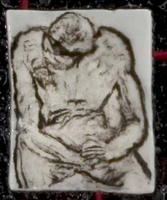Nakedness and Beauty
Living in Venezuela challenged my concepts of beauty. I learned that not all men seek the heroin chic skinny twiggy hard bodies that dominate the images of beauty in the US. I saw women who would be hiding their bodies in the US celebrating them in tight clothes, bright colors and bikinis. And men still looked and admired.
Then I came back to the US. I took a figure drawing class at the Art Sudent's Leaugue of New York. And I found myself most interested in the models with body fat. What I found myself appreciating and celebrating in my drawings was the flexibility of these models. I preferred the models with character. It wasn't the ballet dancer or the swimsuit model that caught my attention, it was the middle-aged, paunchy man with a beard who could hold physically challenging poses for 40 minutes at a time, belying the image his body projected of an unfit man. The honesty of a sagging breast brings to mind the life it has lived -- the babies it nursed, the years it went free and unsupported, the pounding it survived when its owner took to the pavement as a runner. Is there not more beauty in that than in the perky siliconed breast of a woman afraid of aging? Gravity rules and eventually wins.
These are the bodies I use to portray emotions and ideas. The images are not about the model, they aren't about the human body, even. The body is the vocabulary.
I don't like thinking though, that my use of the body alienates a viewer. I have a friend who makes up names or uses obscure terms to name her pieces and doesn't care if people understand. She doesn't seem to be interested in communication, only in expression. She doesn't seem to care if her names alienate the viewer.
I want to communicate. I want to draw the viewer in. I want the viewer to get the idea I am trying to express. Maybe this comes from my years crusading for social justice... Now I want to use art to change the world one person at a time. So how do I resolve this? It doesn't help that it's my family responding negatively to my work. I want to celebrate these pieces and they want to hide them... Isn't that just like family?



